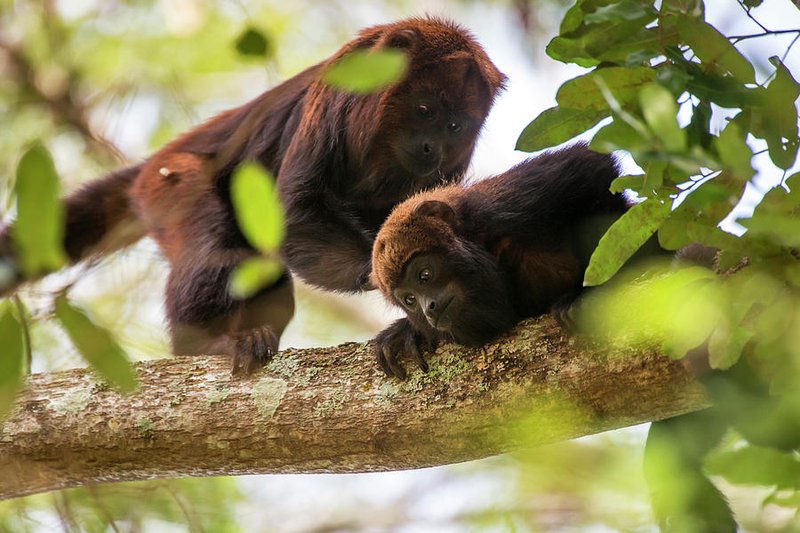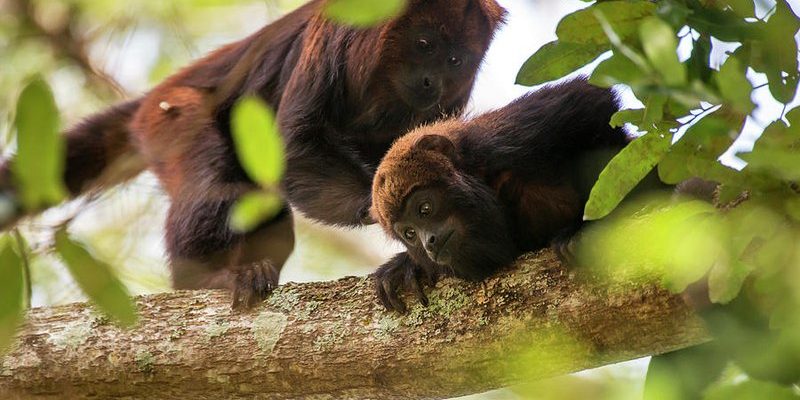
In the dance of life within the jungle, the guariba plays a vital role in maintaining the ecosystem. However, deforestation, habitat loss, and illegal hunting are threatening their existence. Imagine a thriving party suddenly dimming as guests leave one by one. That’s kind of what’s happening to the habitat of the howler monkeys. In this article, we’ll look closely at their status, what’s threatening them, and the efforts being made to protect these incredible animals.
Understanding the Guariba: Species Overview
Guariba, or howler monkeys, belong to the family Atelidae and are primarily found in Central and South America. They’re known for their long tails, which they use as a fifth limb while navigating the treetops. With their distinctive facial features and thick fur, these monkeys are quite the sight. Interestingly, there are several species of howler monkeys, including the black howler, golden-mantled howler, and brown howler.
One of the striking things about howler monkeys is their social structures. They typically live in groups called troops, which can range from just a few individuals to over a dozen. Within these troops, they have a hierarchy, and the males often engage in vocal displays to establish dominance. It’s fascinating how their vocalizations aren’t just for communication; they also serve to mark territory and ward off rivals.
Howler monkeys are primarily herbivores, munching on leaves, fruits, and flowers. Their specialized digestive systems allow them to process tough plant material effectively. So, while they may look like mischievous troublemakers swinging through the trees, these monkeys are actually vital to the forest’s health. They help with seed dispersal, which ensures the growth of new plants and trees.
The Endangered Status of Guaribas
So, are howler monkeys actually endangered? The short answer is yes, but it depends on the specific species. The International Union for Conservation of Nature (IUCN) categorizes many howler monkey species as endangered or vulnerable. For example, the black howler monkey is classified as endangered due to its rapidly declining population.
The threats they face are primarily linked to human activities. Extensive deforestation for agriculture, logging, and urbanization is one of the leading causes of their habitat loss. Picture a vibrant forest suddenly transformed into farmland or concrete jungles. That’s the stark reality these monkeys are confronting—loss of home and food sources.
In addition to habitat destruction, howler monkeys are also victims of poaching. Illegal hunting not only reduces their numbers but also disrupts their social structures. When one member of a troop is taken, it can lead to stress and instability within the group, making their survival even more challenging.
Key Threats Facing Guaribas
Recognizing the dangers faced by howler monkeys is crucial for conservation efforts. Let’s break down some of the most pressing threats:
- Deforestation: As forests are cleared for agriculture and development, howler monkeys lose their homes. This is often the result of logging practices that aren’t sustainable, leaving the animals with fewer places to find food and shelter.
- Habitat Fragmentation: Even if some forests remain, they are often cut into sections, making it difficult for howler monkeys to move between them. This fragmentation can isolate populations, making breeding difficult and reducing genetic diversity.
- Poaching: In some regions, howler monkeys are hunted for bushmeat or captured for the illegal pet trade. This practice can devastate local populations.
- Climate Change: Global warming impacts weather patterns and can lead to droughts or floods, further affecting the habitats and food sources of these monkeys.
Addressing these threats requires a multifaceted approach. It’s not just about planting trees—though that’s important—but also about implementing policies that protect these habitats and ensure the safety of howler monkeys.
Conservation Efforts: What’s Being Done?
Despite the challenges, many organizations and individuals are working tirelessly to protect howler monkeys and their habitats. Here’s a look at some of the most effective conservation strategies:
- Protected Areas: Establishing national parks and wildlife reserves helps safeguard the habitats of howler monkeys. These protected areas serve as safe havens where they can thrive without the threat of human intervention.
- Community Engagement: Educating local communities about the importance of preserving howler monkeys and their ecosystems fosters a sense of stewardship. When people understand the role of these monkeys in their environment, they’re more likely to support conservation efforts.
- Reforestation Initiatives: Planting trees and restoring degraded forests can help rebuild habitats for howler monkeys. These projects often involve local communities, providing jobs and promoting sustainable development.
- Research and Monitoring: Ongoing research is essential for understanding howler monkey populations and their habitats. By studying their behavior and health, conservationists can devise better strategies for protection.
The combined efforts of local communities, governments, and international organizations can make a real difference in the survival of howler monkeys. It’s a team effort that requires dedication and passion.
How You Can Help Guaribas
You might be thinking, “What can I do to help?” Well, there are several ways you can contribute to the conservation of howler monkeys and their habitats:
- Support Conservation Organizations: Donations to organizations that focus on wildlife conservation can directly impact efforts to protect howler monkeys. Look for groups that promote habitat preservation and ethical research.
- Spread Awareness: Share information about howler monkeys and their endangered status with your friends and family. The more people who know about their plight, the greater the chance for change.
- Choose Sustainable Products: By opting for products that are sustainably sourced, you’re helping reduce deforestation and the destruction of wildlife habitats.
- Visit Ecotourism Destinations: Responsible tourism can provide funding for local conservation efforts. When you visit places that prioritize wildlife protection, you’re supporting the local economy while promoting sustainable practices.
Every small action counts, and your support can contribute to a larger movement to save these remarkable monkeys.
In summary, the future of the guariba or howler monkey is uncertain and heavily influenced by human actions. Their endangered status is a stark reminder of the consequences we face when we disrupt ecosystems. However, hope is not lost. With dedicated conservation efforts and public awareness, there’s a path forward.
You don’t need to be a conservation expert to make a difference. Whether through spreading the word, supporting local initiatives, or making mindful choices, every bit helps. Let’s work together to ensure future generations can hear the distinct calls of howler monkeys echoing through the forests, reminding us of the beauty and complexity of our natural world. Together, we can create a positive impact on the lives of these incredible animals and the ecosystems they inhabit.

